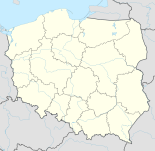Gorek
| Kleinberg (Górki) | ||
|---|---|---|
 Help on coat of arms |
|
|
| Basic data | ||
| State : | Poland | |
| Voivodeship : | Opole | |
| Geographic location : | 50 ° 38 ' N , 17 ° 54' E | |
| Residents : | 664 (March 31, 2011) | |
| Postal code : | 46-060 | |
| Telephone code : | (+48) 77 | |
| License plate : | OPO | |
| Economy and Transport | ||
| Street : | Ext. 414 Prudnik - Opole | |
| Next international airport : | Katowice | |

Gorek (also Gorrek , Polish Górki , 1936–1945 Kleinberg ) is a village in Upper Silesia . Gorek belongs to the municipality Proskau (Prószków) in the powiat Opolski (Opole district) in the Opole Voivodeship .
geography
Geographical location
Gorek is located six kilometers north of the municipality of Proskau and six kilometers south of the district town and voivodeship capital Opole (Opole).
The provincial road Droga wojewódzka 414 runs through the village .
Neighboring places
Neighboring places of Gorek are in the west Dziekanstwo ( Dziekaństwo ), in the north Winau ( Winów ), in the east Follwark ( Folwark ) and in the south Chrzumczütz ( Chrząszczyce ).
history
1306 Gorek was first mentioned as Gorky in a document from Duke Bolesław of Opole . Another mention was made in 1532 as Gorkhy . The name is derived from the Slavic term Górky and means something like small mountain .
In 1534 seven people cultivated eight fields in Gorek.
In 1845 there was a Catholic school, a forge, a weaving mill and 44 other houses in the village. In the same year, 267 people lived in Gorek, all of them Catholic. In 1864, 331 people lived here.
In the referendum in Upper Silesia on March 20, 1921, 223 eligible voters voted to remain with Germany and 164 for Poland. Gorek stayed with the German Empire . 1933 lived in the place 813 inhabitants. On May 19, 1936, Gorek was renamed Kleinberg . In 1939 the place had 893 inhabitants. Gorek was in the Opole district until 1945 .
In 1945 the previously German place came under Polish administration and was renamed Górki and joined the Silesian Voivodeship. In 1950 the place came to the Opole Voivodeship. In 1999 the place came to the re-established Powiat Opolski. On April 30, 2010, the place was also given the official German place name Gorek . Since June 2012 the place-name signs have also been bilingual.
Attractions
- Chapel at the crossroads: In the chapel there is a wooden figure of Jesus and the Virgin Mary. The bell was cast in Nysa in 1658 .
Web links
Individual evidence
- ↑ CIS 2011: Ludność w miejscowościach statystycznych według ekonomicznych grup wieku (Polish), March 31, 2011, accessed on January 8, 2019
- ↑ a b Johann Georg Knie : Alphabetical-statistical-topographical overview of the villages, towns, cities and other places of the royal family. Preuss. Province of Silesia. Breslau 1845. p. 172
- ^ Heinrich Adamy : The Silesian place names, their origin and meaning - A picture from prehistory , Breslau, Priebatsch, 1889, p. 28
- ^ Results of the referendum in Upper Silesia of 1921 for the Opole district ( memento of January 24, 2017 in the Internet Archive ) on home.arcor.de, accessed on January 23, 2015.
- ^ A b Michael Rademacher: German administrative history from the unification of the empire in 1871 to the reunification in 1990. City and district of Oppeln (Polish: Opole). (Online material for the dissertation, Osnabrück 2006).
- ^ Horst Reinhardt: Association for Computer Genealogy. In: gov.genealogy.net. Retrieved January 23, 2016 .

